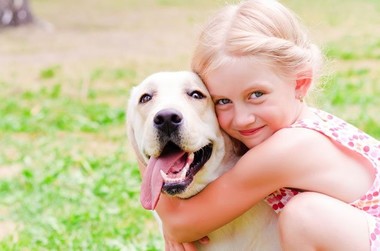
Written by Samantha Delaney, 4th year DCHS veterinary extern
As advocates for the adoption of surrendered, stray, and formerly unwanted pets there is nothing more heartwarming than watching a dog going home with their new family. When a dog is returned it is a sad moment for everyone but when a dog is returned because of a bite it is devastating for numerous reasons. Children are far and away the most common victims of dog bites according to the American Veterinary Medical Association (AVMA). Additionally, a dog with a bite history is more challenging to make available again and find a forever home. The truth is that most bites are preventable. What can we do, as advocates for both the dog and their new family, to help prevent this tragic scenario from playing out? There are three important objectives to recognize when considering dog bite prevention: Recognition of dog behavior, making a safe environment, and respect.
As advocates for the adoption of surrendered, stray, and formerly unwanted pets there is nothing more heartwarming than watching a dog going home with their new family. When a dog is returned it is a sad moment for everyone but when a dog is returned because of a bite it is devastating for numerous reasons. Children are far and away the most common victims of dog bites according to the American Veterinary Medical Association (AVMA). Additionally, a dog with a bite history is more challenging to make available again and find a forever home. The truth is that most bites are preventable. What can we do, as advocates for both the dog and their new family, to help prevent this tragic scenario from playing out? There are three important objectives to recognize when considering dog bite prevention: Recognition of dog behavior, making a safe environment, and respect.
Dog Behavior
Dogs can’t tell us how they are feeling with words but their body language speaks with just as much clarity. Some signs that a dog is uncomfortable include:
- Avoiding eye contact
- Licking their lips
- Tail tucked between their legs
- Stiffened body
- White showing around the eyes
- Moving away from a person or situation
- Crouching low on the ground
- Ears back or pulled tight against the head
- Excessive yawning
- Intense, unblinking stare
- Lifted lip or a ‘smile-like’ grimace
- Raised fur along the dorsum
- Erect tail, might even be wagging slowly
- Growling or rumbling
Safe Environment
Creating a home environment where a dog can feel they have a place that is their own is important. A crate, kennel, or bed space where the dog can have quiet time to themselves provides them with a retreat to calm down and be alone if they need to. There are some activities that can be over stimulating to dogs and being able to separate those without excluding them can maintain safety and the family connection. Baby gates, when used appropriately, can be a great way to create boundaries without excluding the dog. Separating like this for short times is not a punishment and instead it can save them from undue stress. We don’t want adopters to separate them for long periods of the day as this can lead to behavioral problems.
Creating a safe environment also means getting the right type of dog to fit your family lifestyle and providing them with a reliable family structure. Puppy classes, dog training, and obedience are important factors in making a dog feel secure in their position in the family. It also gives you, your children, and your dog the chance to bond in a safe environment while, at the same time, reinforcing good behaviors.
Respect
Respect is an integral part of family structure that should be extended to family pets. Teaching children to respect all animals and particularly those that live in close proximity is going to be a valuable lesson they keep into adulthood. Lessons such as teaching children to approach dogs calmly, to respect their space if they are eating or playing with a toy, and to ask permission to pet an unfamiliar dog will all lead to a happy relationship with their pet and a decreased chance of being bitten. Situations when children should respect the personal space of the family dog include when the dog is:
Creating a safe environment also means getting the right type of dog to fit your family lifestyle and providing them with a reliable family structure. Puppy classes, dog training, and obedience are important factors in making a dog feel secure in their position in the family. It also gives you, your children, and your dog the chance to bond in a safe environment while, at the same time, reinforcing good behaviors.
Respect
Respect is an integral part of family structure that should be extended to family pets. Teaching children to respect all animals and particularly those that live in close proximity is going to be a valuable lesson they keep into adulthood. Lessons such as teaching children to approach dogs calmly, to respect their space if they are eating or playing with a toy, and to ask permission to pet an unfamiliar dog will all lead to a happy relationship with their pet and a decreased chance of being bitten. Situations when children should respect the personal space of the family dog include when the dog is:
- Eating
- Sleeping
- Chewing on a toy
- Over stimulated/ hyperactive
Conclusion
Dog bites are painful, scary, and often lead to a traumatic series of events for everyone involved. The chance to prevent even one of these cases from happening is worth the additional conversation with adopters. Understanding dog behavior, creating a safe environment for family pets, and educating children on appropriate behavior around dogs will all contribute to a decreased risk of a dog bites and increase that dog’s opportunity for a successful forever home.
Some websites with tools to facilitate bite prevention education including coloring pages, workbooks and magazines for children as well as materials for educators and parents are:
-The Humane Society of the United States: http://www.humanesociety.org/parents_educators/
-American Veterinary Medical Association (AVMA) National Bite Prevention Week materials: https://www.avma.org/Events/pethealth/Pages/Dog-Bite-Prevention-Week.aspx
-AVMA Dog Bite Prevention Podcasts and links from specialists: https://www.avma.org/public/Pages/Dog-Bite-Prevention.aspx
Some websites with tools to facilitate bite prevention education including coloring pages, workbooks and magazines for children as well as materials for educators and parents are:
-The Humane Society of the United States: http://www.humanesociety.org/parents_educators/
-American Veterinary Medical Association (AVMA) National Bite Prevention Week materials: https://www.avma.org/Events/pethealth/Pages/Dog-Bite-Prevention-Week.aspx
-AVMA Dog Bite Prevention Podcasts and links from specialists: https://www.avma.org/public/Pages/Dog-Bite-Prevention.aspx
References
- AVMA. “Dog Bite Prevention: Responsible Dog Ownership.” https://www.avma.org/public/Pages/Responsible-dog-ownership.aspx
- Beaver, Bonnie V., DVM, et al. “A community approach to dog bite prevention.” JAVMA. Vol 218.11 (2001): 1732-1749. https://www.avma.org/public/Health/Documents/dogbite.pdf
- ASPCA. “Dog Bite Prevention.” https://www.aspca.org/pet-care/virtual-pet-behaviorist/dog-behavior/dog-bite-prevention
- HSUS. “How to Avoid a Dog Bite: Be polite and pay attention to body language.” http://www.humanesociety.org/animals/dogs/tips/avoid_dog_bites.html?referrer=https://www.google.com/


